NOTE: EasyB plans have been updated as of Jan 2011 - click HERE to download the latest version.
Introduction
Every time I paddle away from shore
in EasyB after spending time in other boats,
mine or others, I’m amazed again at how easy
she moves up to cruising speed. Chuck had expressed
an interest in publishing the plans as a freebie but
I declined since the essence of a computer designed
boat is in the full size frame patterns and I wasn’t
ready to supply paper for nothing. Fast forward a
few years and Adobe’s pdf format has improved
printing capabilities and my ability to present designs
in pdf format has improved also.
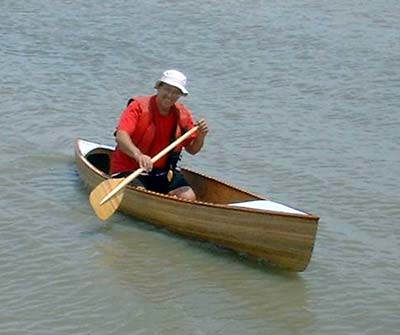
So here is the current iteration of EasyB
including full size patterns requiring a smidgen of
cut and paste if you can print tabloid size, a bit
more at letter size. The only change from the prototype
was to respace the stations to 8” and redo the
stem profile (again, several times, it is a hard curve
to get right).
Plans are presented as is, there are a lot of good
resources regarding stripper canoe construction and
it seems most people will follow their personal preferences
in any case. Anyone building EasyB for sale
might keep in mind there is a large dose of good karma
in compensating the designer for his efforts and some
risk at the other end of the spectrum.
As always I’d be interested in discussing custom
designs/commissions for those interested in such.
EasyB Design Brief
After several years there’s nothing I’d
change in the overall shape of the boat, except the
stem profile. The following is taken from the original
brief with comments on construction changed in tense.

The boat’s shape is derived mathematically
with parabolic curves for plan and profile with superelliptical
cross sections, which guarantees a perfectly fair
shape capable of being manipulated over a wide range.
So our boat is 11’-8” L.O.A. 28”
maximum beam, a bit asymmetric, the midsection 8”
back from the midpoint. The sheer forward is fairly
pronounced both for appearance and to make stripping
easier at the chin of the bow. Just a little rocker,
don’t need a lot of maneuverability in such
a short boat and less rocker also keeps the prismatic
coefficient up a bit, also a good thing in a short
boat. Since an absolutely straight keel line offends
my sensibilities somehow an inch or so will do. At
the 4” waterline, our little boat will displace
4 plus cubic feet of fresh water or 255 pounds with
a prismatic coefficient of 0.56 dragging 18.5 plus
square feet of wetted surface through the water. It
will take about 82 pounds to sink the boat an inch
lower in the water, which should be about as much
as you’d ever want to load the boat. Take 80
pounds out of the 255 leaves 175 pounds and you’ll
be able to float in 3” of water.
Take all this stuff with a small grain of salt, freshwater
or not. In the real world of wind, waves, current
and all sorts of macrocosmic chaos I don’t begin
to understand, A boat is a living dynamic thing, constantly
changing and adapting to the conditions of the moment.
We should all do so well.
Construction is conventional wood stripper, ¼”
nominal wood strips with a layer of glass/epoxy both
sides, 5-oz in this case. Actually 3/16” thick
strips would work fine for a boat this size, but I’ve
got a lot of ¼” thick strips already
on hand and have neither the equipment nor inclination
to take 1/32” off each side. Going to 3/16”
thick strips would save some weight though. There
is (are?) about 33 square feet of hull surface in
EasyB which corresponds to 0.6875 cubic feet of ¼”
strips or 0.516 cubic feet of 3/16” strips.
At 22 pounds per cubic foot that’s 15# versus
11.4#. Rather than trying to save 3 ½ pounds
on this boat, I’ll wait and build a really light
boat (15#) on same form using 9mm PVC foam, kevlar
and s-glass. So 15# hull wood, 5# epoxy/glass and
say 5# bulkheads, deck and gunnels and I’m carrying
a 25# boat (Actual boat weighed 26#).. This I can
do.
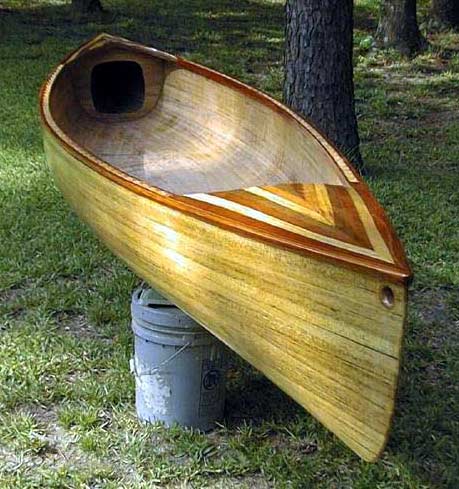
Back to construction. Though conventional scantlings
and lay-up, Easy B was built without using staples,
using rubber bands instead to hold the strips against
forms cut from ¼” pegboard. There was
reason in having 9” (now 8”) station spacing,
easy to do since the shapes are derived mathematically.
Bulkheads were laid up from scrap strips with glass/epoxy
both sides. Decks will be foam sandwich similar to
the Bionic Log, which will allow me to indulge my
minor obsession with book matching. Back when I was
ripping my own strips, It was simple to rubber band
strips together in pairs making it easy to book match
everything. Now I’m content to just book match
the decks with strips resawn to 1/16” veneers
laid over a foam base. Gunnels are spaced with spacers
cut from 1” popular dowels to contrast with
the mahogany gunnels. The extra width using this format
will allow us to not require any thwarts in the boat
plus have a multitude of places to tie or fasten stuff
and anchor footrest, leeboards or whatever.
EasyB has been a pleasure to use and I hope others
find some of the same joy.
The Plans
NOTE: EasyB plans have been updated as of Jan 2011 - click HERE to download the latest version.
Below are the various PDF files you will need to
build EasyB.
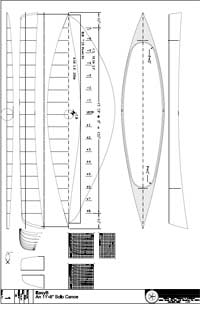 |
Here is the
overview. Click the image to download the PDF
file. |
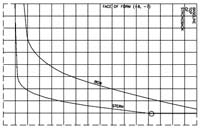 |
Here are the
bow and stern profiles |
Here
are the station molds |
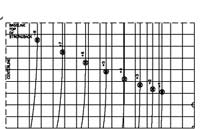
Fore Upper |

Aft Upper
|
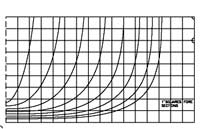
Fore Lower |
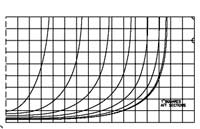
Aft Lower
|

Other articles by Skip Johnson:

|